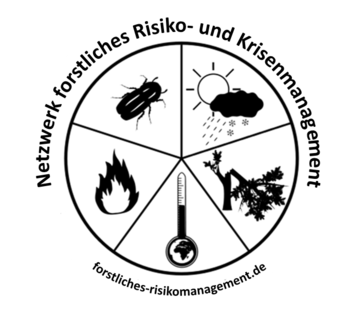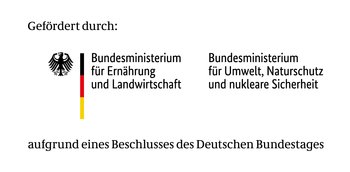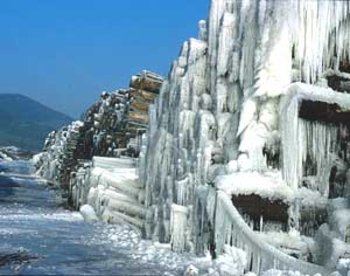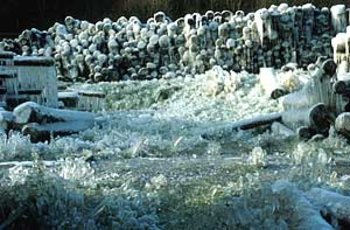Wet storage is based on keeping wood moisture above 120%. Moisture loss in wet stored timber by evaporation also occurs in winter, especially during warmer and dry spells. Due to the lower air humidity in winter, the evaporation can be higher than in summer.
- Procedure
Irrigation needs to be kept up during winter as well to avoid damage during storage. In no case may the irrigation system be switched off during winter and put back into operation the following spring. A protecting ice crust around the logs can be formed only by closely monitored irrigation at temperatures below 0 °C. As this prevents evaporation, irrigation can be suspended while snow cover is constant and the logs are permanently frozen.
- Monitoring
The irrigation system needs to be closely monitored during winter to prevent damage to the timber and the system itself and to allow for a speedy restart if the weather conditions make it necessary.
- Road safety
Hazard of ice formation should be signposted on paths near irrigation systems. Users of public roads must not be put at risk by ice formation from wet storage landings. Therefore, sprinklers with roads within throwing range must be either switched off, shielded, or moved out of reach during times of frost (remember to take wind drift into account). Safety will override timber preservation! Additionally, the danger of glazed frost should be signposted.
General informationn
- Water from rivers and streams is usually colder than water from deep wells. Water from rivers will therefore reach freezing point faster.
- Water circulating in the piping does not freeze as quickly as standing water. Systems running at intervals are therefore more likely to freeze up than permanently running systems. However, systems running at intervals can be operated at temperatures as low as –5 °C if the intervals in which the water is not running are kept below 10 minutes. A temperature-sensitive control unit can be used to start the system when night temperatures reach freezing point. If such a device is not available, the irrigation has to be left running all night through. If a licence for all-night operation can not be obtained, the irrigation system needs to be shut down. An amicable solution for cold periods should be agreed upon with the authorities at an early stage.
- Full-circle sprinklers work, depending on make and model, down to –5 °C. Experiences so far showed that irrigation systems can be operated down to this temperature if the water is kept in motion. Whenever temperatures drop below that point, the system has to be switched off and drained completely (feed pipes, aboveground pumps, magnetic valves, etc.).
- Part-circle sprinklers don’t work properly in low temperatures, as the reversing mechanism ices up quickly.
- Crampons and protective clothing are absolutely necessary when walking on the stacks. Working in teams of two is highly recommendable.
Basic preparation of the system
- Pressure pipes should be laid with a slight incline (using wooden posts) where possible. Concentrating on a few low points can ease and accelerate later draining of the pipes.
- Hoses feeding the sprinklers should be laid out gradiently on the stacks.
- Permanently installed suction pipes should have a drainage pipe (e.g. tapping clamp with shutter).
- Magnetic valves should be jacketed in rock wool or felt (approx. 15 cm) and covered rain proof (tarp, etc.). A heating band can be installed where electric power is available.
Transitional periods spring/autumn
- Moderate night frosts (down to –5 °C) occur during transitional periods in spring and autumn, while daytime temperatures can be well above 0 °C.
- Irrigation is still necessary.
- The system is fully operable, but intensive servicing is necessary.
- An ice crust is formed on the irrigated surfaces.
Measures
Systems with one irrigation circle
- Switch to continuous operation when temperatures drop below 0 °C (usually at night).
- Switch part-circle sprinklers to full-circle mode to avoid icing up of the reversing mechanism.
- Fully lower radius adjustment screw (if existent).
Systems with several irrigation circles (magnetic valves for 2-3 circles, or two-way interlocked pumps)
- If irrigation is run in intervals, the breaks have to be kept as short as possible. Maximum irrigation stop for a circle is 10 minutes. Magnetic valves have to be protected against frost (see above).
- Switch part-circle sprinklers to full-circle mode to avoid icing up of the reversing mechanism.
- Fully lower radius adjustment screw (if existent).
Winter
- Permanent frost over several weeks and daytime temperatures hardly over 0 °C.
- Irrigation is no longer necessary. A protecting ice crust is formed around the logs.
Measures
Draining the piping without compressed air
- Magnetic valves have to be dismantled and stored empty and frost-free.
- All piping which has not been installed frost-free has to be rinsed thoroughly and emptied afterwards. This means:
- Open all connectors at low points. Place pipes parallel, pipe ends next to each other.
- Open buckles of suspension pipes to avoid tension.
- Let water run out of the hoses, beginning at the sprinkler end.
- Hoses and pipes are usually frostproof when empty and can be stored on-site with the sprinklers.
- Open all sliders and tabs of the system and leave them open.
Draining the piping using compressed air
- A compressor can be used to drain the piping of bigger irrigation systems or where the piping is no longer accessible or has been installed without enough incline. The whole piping system has to be ice-free for this!
- The compressor should be a regular building site machine, 3-4 cylinders, output 4 m³ (4 bar) of air, and is connected directly to the irrigation piping. Such compressors can usually be easily (during winter) hired from local building companies or special rental businesses.
- Compatible joints for the piping are available from specialised traders.
- The main service pipes are drained first. The valves leading towards the hoses have to be closed off to prevent dirt particles from getting into the nozzles of the sprinklers. Temporary covers at the ends of the piping need to be removed. They can be replaced by valves to slow down the sudden pressure drop and refitted after draining the system.
- The ball valves on the outgoing hosepipes are then opened fully and blown out one by one, and then set to 45°. It is also possible to set the ball valves to 45° while the system is still running, and then blow the whole system out in one go.
- Draining the irrigation system line by line proved to be advantageous. It might be necessary to repeatedly close the adjusting gate valves at the branching points of the system and wait for a couple of minutes until enough air pressure has been built up. If there is no such a valve, one replacing the temporary covers at the ends of the piping can be used instead. If the compressor is not powerful enough to drain the lines in one go, they will have to be blown out bit by bit while the remaining piping is blocked.
Pumps
Centrifugal-/close-coupled pumps
- The pump must be emptied completely. The draining plug is usually located at the bottom of the casing, the ventilation screw on top (see manual). Don’t let the pump run dry. The blade wheel of the pump has to be cleaned (at the latest before reconnection). The seals may be checked (usually not necessary).
- The casing can be opened to check and clean the rotor discs.
- Cleaning Grundfos pumps is very complicated. It should be done by a specialist.
- The suction pipe has to be emptied (pull suction valve), removed from the extraction sewer, and stored in a dry place.
Underwater pumps
- Frostproof well pumps can be left in the well if the pressure pipe is emptied down to below the frost line. The sewer should be covered up in any case to protect it from frost. Also, the riser above the waste valve must be emptied.
- If a frostproof environment for the pump in the well can not be guaranteed, it has to be removed, emptied, and stored in a frost-free room. Don’t forget to refill the pump with water before putting it back into operation.
Pressure pipes
Pressure pipes can be opened at the low points and drained, provided they have been installed inclining. Hoses and sprinklers are disconnected at the branch valves and drained. They can stay put and are virtually maintenance-free. It is recommendable to re-connect the hoses to the pipes to avoid them being used as wintering burrows for small mammals (blocked pipes!). The same applies for all other pipes and openings.
Magnetic valves
- If possible, the pilot valve should be dismantled and stored frost-free.
- The valve can stay put if the service pipes are drained, but it should be protected from water impact by covering it up.
Electrical equipment
- Main switch “off”, remove fuses.
- Also remove the fuses of the hand-over point main switches to protect the pump installation from unauthorised operation.
Longer frost-free periods and reconnecting in spring
The ice crust has melted, several larger parts of logs are bare. The irrigation system has to be put back into operation right away.
Pump inspection
Even when handling appropriately, pumps can get rusty. This should be checked in spring. Try to spin the impeller with a screw driver. If this is not possible with usual effort, take off the grid and try to turn the trunnion link with a pair of channel-lock pliers. If this also fails, take off the side panel (on the side of the blade wheel) and try turning the trunnion from here.
Other measures
- Re-close piping and hoses.
- Re-install the pump. Suction pipes and pumps must be water-filled up to the pressure gate valve. Never let the pump (underwater or suction pumps) run dry.
- Close draining plug (don’t forget the washer).
- Re-start the pump under lowered pressure. Close the pressure gate at the pump/ the pressure pipe. Start pump and let run against closed gate. Then open the gate slowly, trying to keep the operating pressure at the same level. Open the gate fully when all pipes are filled and all sprinklers are working.
The scenarios as described above are simplified and may not always apply to local conditions. It is therefore recommended to prepare an individual checklist for shutting down and reconnecting every irrigation system in advance. This will keep time and effort low and reduce risk of error.
Sources
- Willmann, R. (2000): Nasslager – Winterbetrieb. Internes Merkblatt der Forstdirektion Freiburg.
Forest Crises Management Advisory Guide
Back to the main page of the Forestry Crisis Management Advisor Guide: Overview of the different topic collections
Back to the article overview in the: Storm Topic Collection – Coping with Storm Damaged Timber




